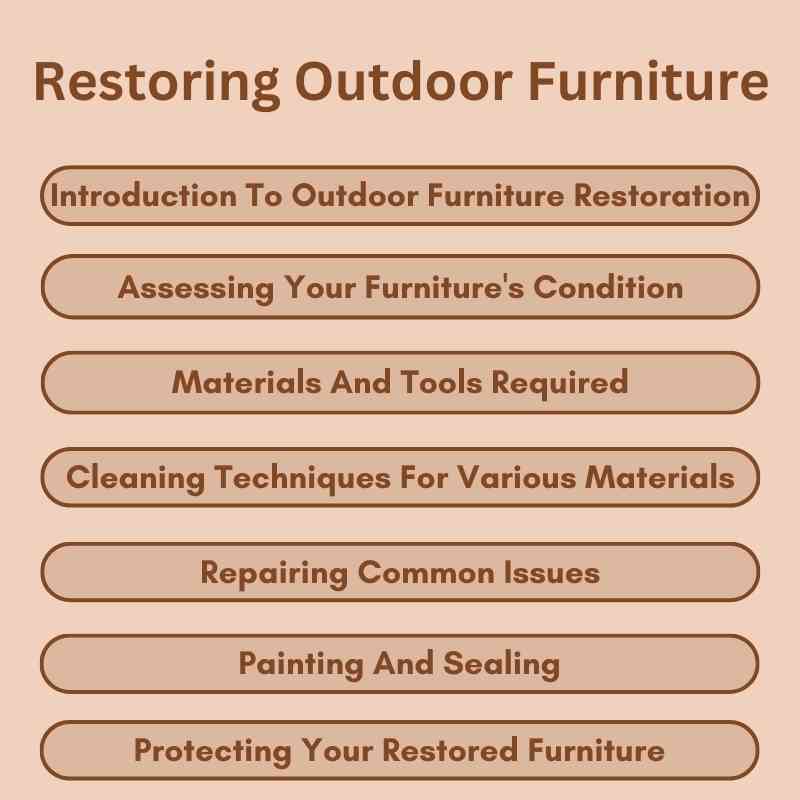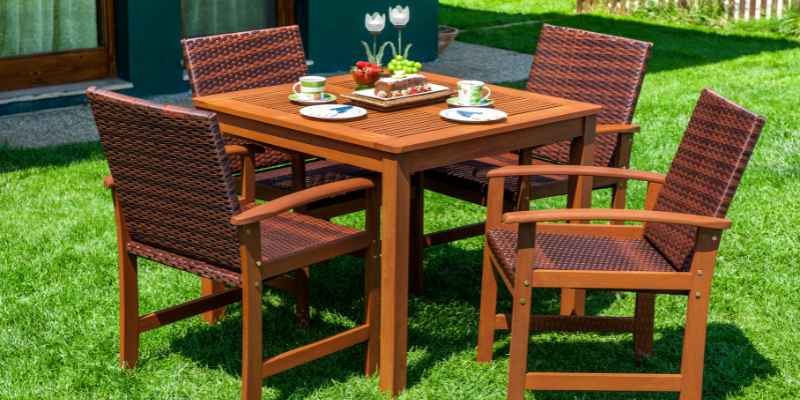Restoring outdoor furniture involves cleaning, sanding, and refinishing surfaces. This process revitalizes the look and extends the furniture’s lifespan.
Outdoor furniture often endures harsh weather conditions, leading to wear and tear. Over time, dirt, moisture, and UV rays can damage materials like wood, metal, and wicker. Regular maintenance is essential to keep your outdoor pieces looking their best. Restoring furniture not only enhances aesthetics but also improves durability.
Begin by thoroughly cleaning each piece to remove grime and mildew. After cleaning, assess for scratches or damage, and sand those areas down. Finally, apply a protective finish to shield against future elements. With proper care, your outdoor furniture can remain beautiful and functional for years to come.
Introduction To Outdoor Furniture Restoration
Restoring outdoor furniture brings back its original charm and beauty. A revived patio offers a cozy space for family and friends. It creates a welcoming atmosphere for gatherings.
Choosing to restore instead of buying new has many benefits. First, it is often cost-effective. Restoring furniture saves money compared to purchasing new items. Second, it is eco-friendly. This process reduces waste and helps the environment.
Finally, restoring furniture can be a fun DIY project. It allows creativity and personal touches. Skills are gained and memories are made during the process.

Assessing Your Furniture’s Condition
Check your outdoor furniture for visible damage. Look for cracks, chips, or rust. These signs show that restoration is needed.
Examine the fabric for fading or tears. This can affect both comfort and appearance. Wooden furniture may have scratches or discoloration.
Consider the overall stability of the furniture. Wobbly chairs or tables may need repairs. Determine how much work is required for each piece.
Make a list of items needing attention. Prioritize based on importance and usability. This will help in planning your restoration project.
Materials And Tools Required
To restore wooden furniture, you need some basic supplies. Start with sandpaper to smooth rough areas. Use wood glue for any loose joints. A good stain or paint will refresh the look. Don’t forget sealer to protect the surface. A brush or roller helps apply these finishes.
For metal pieces, gather a different set of tools. Wire brushes clean rust and dirt. Use metal primer for better paint adhesion. Choose a weather-resistant paint to keep the metal safe. Protective gloves and a mask ensure safety during the process. Always work in a well-ventilated area.
Cleaning Techniques For Various Materials
For wooden outdoor furniture, natural solutions work best. Mix equal parts of vinegar and olive oil. Apply it with a soft cloth. This mixture cleans and shines the wood. Use a gentle scrub brush for tough stains.
For rust removal on metal furniture, try baking soda. Make a paste with water and apply it. Let it sit for 30 minutes. Scrub with a steel wool pad to remove rust. Rinse with water and dry thoroughly.
Repairing Common Issues
Fixing loose joints and screws is simple. First, use a screwdriver to tighten all screws. If a joint is loose, apply wood glue and clamp it. Allow the glue to dry before using the furniture.
Mending tears in fabric requires a few steps. Start by cleaning the area around the tear. Use a needle and thread to sew the tear closed. For larger tears, use fabric glue or an iron-on patch. Make sure to smooth the fabric after repairs.
Painting And Sealing
Choosing the right paints is crucial for outdoor furniture. Acrylic paints are great for wood. They are durable and resist fading. Oil-based paints offer a strong finish but take longer to dry. Always pick paints with UV protection to prevent sun damage.
Sealants are important for longevity. They protect against moisture and dirt. Polyurethane sealants are popular for their strength. Water-based sealants dry quickly and are easy to clean. Make sure to apply sealants after the paint is dry. Regular maintenance keeps furniture looking new.
Protecting Your Restored Furniture
Protect your restored outdoor furniture with proper weatherproofing strategies. Use water-resistant covers during rainy seasons. This prevents moisture from damaging wood and fabric.
In winter, store furniture in a dry, sheltered area. This keeps it safe from snow and ice. For summer, apply a UV protectant to guard against sun damage.
During spring, clean furniture with mild soap and water. This removes dust and dirt that can cause wear. Fall is the perfect time to check for repairs and touch-ups.
| Season | Tip |
|---|---|
| Winter | Store in a dry place |
| Spring | Clean with soap and water |
| Summer | Apply UV protectant |
| Fall | Check for repairs |
DIY Vs. Professional Restoration
Deciding between DIY and professional restoration can be tricky. For small jobs, DIY may save money. However, complex projects often need expert skills.
Consider calling the experts if:
- The damage is extensive.
- You lack the right tools.
- Time is a concern.
Here’s a simple cost comparison:
| Option | Estimated Cost |
|---|---|
| DIY Restoration | $50 – $200 |
| Professional Restoration | $200 – $800 |
Finishing Touches For A Cozy Ambiance
Accessorizing your patio can create a cozy atmosphere. Start with string lights to add warmth. They create a magical glow in the evenings. Lanterns can also provide soft light and charm.
Use outdoor cushions to enhance comfort. Bright colors and patterns can make your space inviting. Don’t forget to add a rug to define the area. A rug can make your patio feel like a room.
Choose decorative pillows for extra flair. They can be easily changed with the seasons. Add some plants for a touch of nature. Potted plants or hanging baskets brighten up the space.
Incorporate table decor for special occasions. Use simple centerpieces like candles or flowers. This adds a personal touch to your outdoor dining experience.
Conclusion: Enjoy Your Revitalized Outdoor Space
Restoring outdoor furniture brings a sense of satisfaction. It turns worn pieces into beautiful additions for your space. Each step in the journey reveals hidden potential. You learn the importance of care and attention. Enjoying the results makes the effort worthwhile.
Inviting friends and family over creates lasting memories. They can admire your hard work and enjoy the revitalized area. Sharing stories and laughter becomes even better in a welcoming space. A fresh look encourages outdoor gatherings and fun activities.
Outdoor furniture restoration not only enhances aesthetics but also adds value. A well-maintained area invites people to relax and connect. Embrace this journey and celebrate your achievements with loved ones.

Frequently Asked Questions
How Can I Clean Outdoor Furniture Effectively?
To clean outdoor furniture effectively, start by removing any loose dirt and debris. Use a mixture of mild soap and water for cleaning. A soft brush helps reach crevices. Rinse thoroughly with clean water and allow it to dry completely to prevent mold or mildew buildup.
What Materials Are Best For Outdoor Furniture Restoration?
The best materials for outdoor furniture restoration include high-quality wood sealants, outdoor fabrics, and rust-resistant metal finishes. These materials enhance durability and weather resistance. Always choose products designed for outdoor use to ensure longevity and maintain the aesthetic appeal of your furniture.
How Often Should I Maintain Outdoor Furniture?
You should maintain outdoor furniture at least twice a year. Regular maintenance includes cleaning, inspecting for damage, and applying protective coatings. Seasonal changes can affect materials, so proactive care extends the life of your furniture. Adjust frequency based on weather conditions in your area.
Can I Use Bleach On Outdoor Furniture?
Using bleach on outdoor furniture is generally not recommended. Bleach can damage finishes and fabrics, leading to discoloration. Instead, opt for a gentle soap solution to clean. If mold or mildew is present, consider using a diluted vinegar solution for a safer alternative.
Conclusion
Restoring outdoor furniture is a rewarding project that enhances your outdoor space. By following the right techniques, you can breathe new life into old pieces. Regular maintenance will prolong their lifespan and keep them looking fresh. Enjoy a beautiful and inviting outdoor area with your revitalized furniture for years to come.

